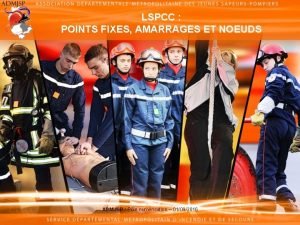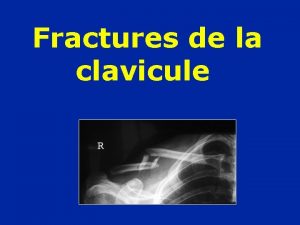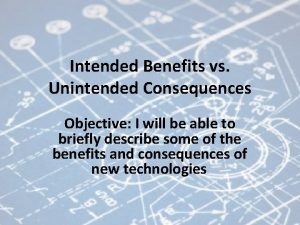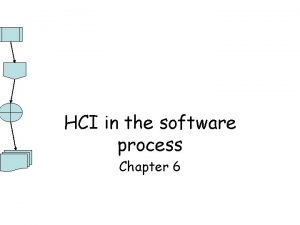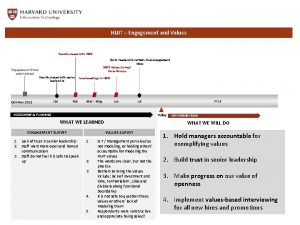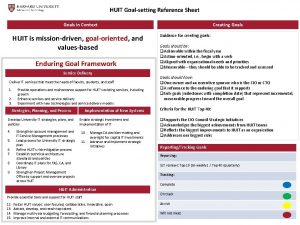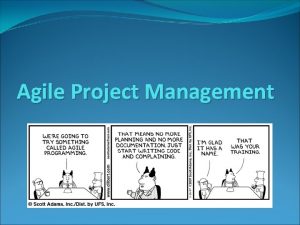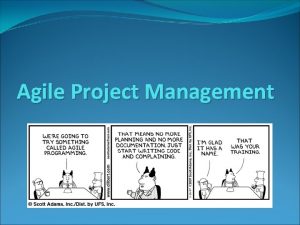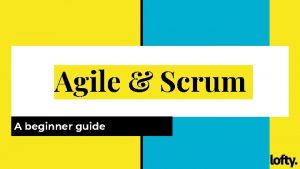Agile in HUIT Meeting Purpose and Intended Outcomes
















- Slides: 16

Agile in HUIT

Meeting Purpose and Intended Outcomes Purpose Share observations and suggestions for HUIT Agile teams Intended Outcomes • Reflect on some common themes across groups as result of ongoing Agile Journey • Highlight opportunities to build upon the progress that has been made • Confirm the work of the Agile Coaches is aligned with your needs 2

Key points about Being Agile is a framework built upon a mindset, values, principles, and practices which enable Teams to frequently and incrementally deliver value. • Agile teams are on a journey – emerging, evolving and different team to team - focus team on goals, allow them to figure out how to accomplish • Speed up a team by removing what is slowing them down, not exerting more pressure • Concentrate planning on the Outcomes (benefits to users), not the Outputs (things to do) plus the boundaries (dates, budget, etc. ) • Leverage Agile techniques on non-development efforts with complex goals involving multiple people – with some adjustments on techniques 3

Findings Based on Observations across HUIT • Academic Technology Services • College and Athletics • Library Technology Services • Account Management • CTO Program Management • Office of President and Provost • Agile Work Group • FSS • PM Co. P • Aurora • Grants Management • Server Systems • CAADS (Alumni Affairs) • HUIT UX Experts • SIS • CADM IT Integration • Identity and Access Management • Teaching and Learning Technologies • Cloud Lift and Shift • IT Summit Observation were made during: – Facilitating Retrospectives – Discussions with Scrum Masters, Project Managers, Product Owners, Directors, Managers, Managing Directors – Coaching Sessions with Team – Staff Meetings – Topic specific discussions – Leading Agile Work Group (Cross Harvard group working to create Agile Co. P and IT Academy Agile courses) 4

Observed Themes • Strengths: – – Buy-in overall that Agile is beneficial Willingness to improve processes and talk about them Available Agile leaders in some units and across Harvard Momentum from high visibility projects and IT Summit • Opportunity Areas: – – Enhance how users and value are represented in every aspect of work Strengthen team planning and increase visibility of work and progress Align teams based on ability to deliver Services Invest time to improve team processes and clarify roles and responsibilities 5

Training As of June 30 - HUIT: • 282 employees – 32% overall, 16% Managers based on ASPE numbers • Bootcamp brought in house and rebranded to Agile. Foundations. • Changes to highlight area based on feedback from teams Goal: • All employees complete Agile – Foundation or have completed Bootcamp • Including all Managers, all groups 6

Goals • 4 Themes turn into Goals • Under the Strategic Planning place • Align efforts with PM, ITSM, Account Management, and Agile • Options for Coaches: assigned to Service Delivery area and available to work with Programs as teams desire 7

Deeper dive into the 4 topic areas 8

Decoupling Agile Team membership from reporting structure Current Example BA Manager Dev Manager Ops Manager BA Dev Ops BA/QA Dev Ops 9

Decouple Agile Team membership from reporting structure Teams designed to deliver value - Roles on an Agile team is not tied to the job families, titles, or reporting structure. Dev Manager BA Manager Product Owner Service Owner BA Scrum Master BA BA/QA Product Owner Service Owner Scrum Master Dev Team Member Dev Team Member Ops Ops Dev Team Member Ops Manager Team Member Ops Team Member 10

Enhance how users represented in all work • Observations: – – Work tends to be a list of technical activities not a description of benefits or value to users Missing or blurry lines from the Project Vision or Service Roadmap to daily activities Some Product Owners are filling in - not able to manage the backlog or have role conflicts Some teams have not aligned customer engagement with their Agile processes or other teams causing confusion • Suggestions: – Align IT work more clearly to Project or Service Roadmaps and stakeholders’ goals – Ensure Product Owners can represent users needs and make decisions about what is most important to get done – Define engagement model that aligns with Agile process - Consider Reviews, Demos, Sprint Plans • Benefits: – Team can develop better products when they understand what the customer is trying to do and why it is important – Customers understand what the team is working on and what value or benefits they will receive 11

Strengthen team planning and increase visibility • Observations: – Not including all work to complete goal (ex. Change Mgmt, Operations, Configuration) – Planning based on work desired to be complete in a sprint and by individual – Not reporting planned, then complete (with demo) or not done (some teams improved in FY 16) • Suggestions: – Ensure Product Owner keeps work list (backlog) accurate to capture user needs and value – Encourage team to base plans on demonstrated ability to complete, without pushing for more – Nurture teams to share work, progress, and challenges early and often for feedback and to keep customers and management informed • Benefits: – Team is more confident in ability to deliver – will make better planning and technical decisions – Teams tend to become more productive when in control of process and set up to get to “done” – Visibility increases customer confidence – Making technical changes and business adjustments are cheaper and easier when done early 12

Create cross-functional Agile teams better able to deliver a Service • Observations: – – Many teams are formed based on management reporting structure only Work is defined without the ability to deliver to users Work that needs to go to another team or group dramatically slows productivity Teams are changing often, consultants come and go • Suggestions: – Define Agile teams by work needed from request to delivery – Keep teams stable (goal: at least 6 months- 1 year) to get to high-performing • Benefits: – Better control of customer experience - what is adding / detracting from the process – Stable teams enable member to grow skills and work more efficiently together 13

Invest Time to Improve and clarify roles and responsibilities • Observations: – Many teams say they feel empowered to make process changes within their team, but do not have the tools, knowledge, or time – Misunderstand roles in Agile – SM, PM, Team Member, PO, Service Owner, and Manager • Suggestions: – Treat process changes with the same importance as user stories or features – Increase dialogue around process improvements and share techniques across teams – Allow teams to experiment and sometimes fail – some attempts do not work as planned but offer great learning, others cause a giant leap forward • Benefits: – Team feels more engaged because they feel ownership and when they measure they can demonstrate how they improved – Team removes things getting in their way so they tend get more productive – Individuals feel more valued because they can share their knowledge with peers 14

Improvement Approach 1. Ensure Agile Foundation covers concept at a foundation level (Agile Work Group) – Agile Foundation class to be delivered in house, more often and update – July 28 -29 2. Build on individual Agile skills by encourage collaborating across teams and offering Agile events – Create Agile Community of Practice (Co. P) – launched 7/8 – Define IT Academy Agile Level 2 and 3 – lynda, and external events, and Agile Co. P events: Next: (July 25) How do I improve my Retrospectives and (Sept 8) A Day in the Life of a Scrum Master – Launch Agile website and collaboration tool – early fall 3. Identify how to report on team progress and improvement in the areas of Representing Customers, Planning, Defining Teams, and Continuously Improving 4. Coach teams, individuals, stakeholders - pull request by teams or Management – Short, topic specific engagement, pull in as needed – teams measure improvement – Longer - work with team to create a baseline, define improvement and measure, implement change, measure, and adjust – Participate in Consultant Process - Screen Project Manager and Scrum Masters, create a list of questions Managers can ask during recruiting process 15

Thank you! 16
 Zero un deux trois quatre cinq six sept huit neuf
Zero un deux trois quatre cinq six sept huit neuf Bondage en huit
Bondage en huit Echantignolles
Echantignolles Signe de la touche de piano épaule
Signe de la touche de piano épaule Guibert vmo
Guibert vmo Abc with pronunciation
Abc with pronunciation Purpose of learning outcomes
Purpose of learning outcomes What is meeting and types of meeting
What is meeting and types of meeting What is meeting and types of meeting
What is meeting and types of meeting Today meeting or today's meeting
Today meeting or today's meeting Today meeting or today's meeting
Today meeting or today's meeting Fuses and circuit breakers are intended primarily for the
Fuses and circuit breakers are intended primarily for the Fuses and circuit breakers are intended primarily for the
Fuses and circuit breakers are intended primarily for the It has 4-5 inches finely tapered blades.
It has 4-5 inches finely tapered blades. A long uninterrupted speech
A long uninterrupted speech What is intended benefit
What is intended benefit Simulate or animate some features of intended system
Simulate or animate some features of intended system


